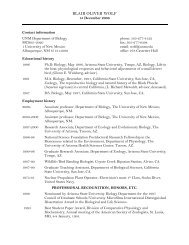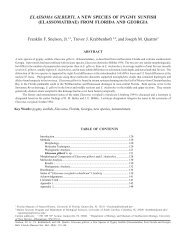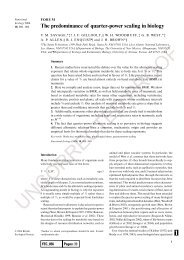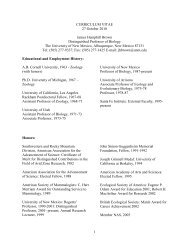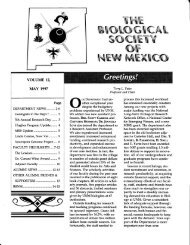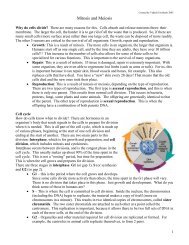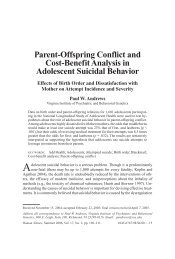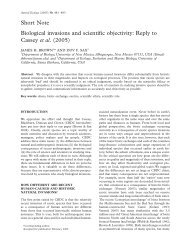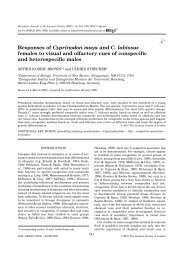What is Biomphalaria glabrata? - Biology
What is Biomphalaria glabrata? - Biology
What is Biomphalaria glabrata? - Biology
You also want an ePaper? Increase the reach of your titles
YUMPU automatically turns print PDFs into web optimized ePapers that Google loves.
<strong>What</strong> <strong>is</strong> <strong>Biomphalaria</strong> <strong>glabrata</strong>?<br />
<strong>Biomphalaria</strong> <strong>glabrata</strong> <strong>is</strong> a mollusc and thus represents the lophotrochozoan clade of animal<br />
life. It <strong>is</strong> a tropical freshwater snail indigenous to ponds, marshes and streams of South<br />
America and some of the Caribbean <strong>is</strong>lands. It <strong>is</strong> an important intermediate host of the<br />
parasite Sch<strong>is</strong>tosoma mansoni that infects ~83 million people.
An Overview of Animal Phylogeny<br />
CHORDATA<br />
HEMICHORDATA<br />
ECHINODERMATA<br />
ARTHROPODA<br />
TARDIGRADA<br />
ONYCHOPHORA<br />
NEMATODA<br />
NEMATOMORPHA<br />
PRIAPULIDA<br />
KINORHYNCHA<br />
BRYOZOA<br />
BRACHIOPODA<br />
PHORONIDA<br />
ANNELIDA<br />
MOLLUSCA<br />
SIPUNCULIDA<br />
PLATYHELMINTHS<br />
PLACOZOA<br />
CNIDARIA<br />
PORIFERA<br />
DEUTEROSTOMES<br />
ECDYSOZOANS<br />
LOPHO-<br />
TROCHOZOANS<br />
NO<br />
LOPHO-<br />
TROCHOZOAN<br />
IS A “MODEL<br />
ORGANISM”<br />
Tree Modified from Conway Morr<strong>is</strong> (1998) and Valentine et al., 1999
Phylum Mollusca<br />
• >50 thousand living species<br />
• Includes the largest and the most intelligent invertebrates<br />
• Of commercial and public health importance<br />
• Understudied with respect to genome sciences<br />
250<br />
70<br />
600<br />
11<br />
8000<br />
350<br />
650<br />
>40,000<br />
SOLENOGASTERS (shell-less, worm-like molluscs)<br />
CAUDOFAUVEATA (shell-less worm-like molluscs)<br />
POLYPLACOPHORA (the chitons)<br />
MONOPLACOPHORA (rare deep sea molluscs)<br />
BIVALVIA (clams, oysters, scallops)<br />
SCAPHOPODA (tusk shells)<br />
CEPHALOPODA (chambered nautilus, squids, octopuses)<br />
GASTROPODA (snails, slugs, sea hares, abalones)<br />
A plausible scenario for the phylogenetic relationships among the major groups of molluscs (see Medina and Collins, 2003;<br />
Passamaneck et al., 2004 for d<strong>is</strong>cussions).
Class Gastropoda<br />
• >40 thousand living species of snails<br />
• ancient origins, in the Cambrian<br />
• B. <strong>glabrata</strong> <strong>is</strong> a relatively derived gastropod<br />
A plausible scenario of relationships among gastropods (see Medina and Collins, 2003; Passamaneck et al., 2004 for d<strong>is</strong>cussions).<br />
Note the family Planorbidae shown in red, to which B. <strong>glabrata</strong> belongs.
FAMILY PLANORBIDAE<br />
• About 40 genera<br />
• Cosmopolitan, in almost<br />
any lake, pond or stream<br />
• Shell often d<strong>is</strong>coidal<br />
• Animals with accessory<br />
“gill” called a<br />
pseudobranch<br />
• Hemolymph <strong>is</strong> red due to<br />
the presence of<br />
hemoglobin<br />
• Are frequently important<br />
hosts for sch<strong>is</strong>tosomes,<br />
including species other<br />
than S. mansoni<br />
(From Malek, 1985)<br />
Adult Sch<strong>is</strong>tosoma bov<strong>is</strong> worms, from<br />
cattle in Kenya, transmitted by another<br />
planorbid snail genus, Bulinus.
• About 34 species, in tropical<br />
America, Africa and the Arabian<br />
Peninsula<br />
• Originated in the Neotropics<br />
and an ancestral snail very<br />
much like B. <strong>glabrata</strong> colonized<br />
Africa less than 5 million years<br />
ago ( see * on tree)<br />
• 18 species are known or likely<br />
hosts for S. mansoni, a parasite<br />
that originated in Africa<br />
• B. <strong>glabrata</strong> <strong>is</strong> the most<br />
important host in the Neotropics<br />
23 SPECIES, PARTIAL MITOCHONDRIAL<br />
16S AND COMPLETE NUCLEAR<br />
RIBOSOMAL ITS1 AND 2<br />
The genus <strong>Biomphalaria</strong><br />
10<br />
*<br />
pfeifferi Senegal<br />
stanleyi Uganda*<br />
pfeifferi Cameroon<br />
pfeifferi Sudan<br />
pfeifferi Madagascar<br />
camerunens<strong>is</strong> 1999 Cameroon<br />
camerunens<strong>is</strong> 2000 Cameroon<br />
sudanica Kenya<br />
sudanica Tanzania<br />
choanomphala Tanzania*<br />
alexandrina 1997 Egypt<br />
alexandrina 1993 Egypt<br />
smithi Uganda*<br />
<strong>glabrata</strong> Dominican Republic<br />
<strong>glabrata</strong> Puerto Rico<br />
<strong>glabrata</strong> Brazil<br />
<strong>glabrata</strong> Venezuela<br />
kuhniana Dominica<br />
kuhniana Colombia<br />
kuhniana Venezuela<br />
straminea PE Brazil<br />
straminea SP Brazil<br />
intermedia Paraguay<br />
amazonica AM Brazil<br />
amazonica RO Brazil<br />
B. sp. Bolivia<br />
tenagophila Paraguay<br />
tenagophila Brazil<br />
occidental<strong>is</strong> Brazil<br />
prona LkV, Venezuela*<br />
prona SaC, Venezuela<br />
andecola Bolivia<br />
B. sp. (havanens<strong>is</strong>? HbL, Cuba<br />
B. sp. (havanens<strong>is</strong>?) Zf, Cuba<br />
B. sp (havanens<strong>is</strong>?) Puerto Rico<br />
temascalens<strong>is</strong> Mexico*<br />
obstructa USA<br />
obstructa Mexico*<br />
helophila<br />
peregrina Uruguay<br />
peregrina Brazil<br />
Cuba<br />
schrammi Brazil<br />
Hel<strong>is</strong>oma trivolv<strong>is</strong> USA<br />
DeJong et al., 2001<br />
AFRICAN<br />
NEOTROPICAL
Variation within <strong>Biomphalaria</strong> <strong>glabrata</strong><br />
• There are 6 well-delineated clades within B. <strong>glabrata</strong>, four from geographically<br />
overlapping areas in Brazil<br />
• These are ~4X more diverse genetically than the most important intermediate<br />
host for S. mansoni in Africa, <strong>Biomphalaria</strong> pfeifferi<br />
*BB02 <strong>is</strong>olate selected<br />
for sequencing from<br />
th<strong>is</strong> clade<br />
Based on partial 16S and ND-1 sequences of the mitochondrial genome, DeJong et al., 2003.<br />
*
Ecology of <strong>Biomphalaria</strong> <strong>glabrata</strong><br />
A small, heavily-polluted stream near Belo<br />
Horizonte, Brazil, that harbored thriving<br />
populations of B. <strong>glabrata</strong>, here being collected<br />
with a small scoop. Th<strong>is</strong> habitat <strong>is</strong> a<br />
transm<strong>is</strong>sion site for Sch<strong>is</strong>tosoma mansoni.<br />
A pond in Brazil where<br />
B. <strong>glabrata</strong> <strong>is</strong> present.<br />
A Venezuelan pond in which B. <strong>glabrata</strong><br />
was abundant (note the many whitened<br />
shells of dead snails that have floated to<br />
the surface).<br />
• Eat bacterial films, algae, diatoms and decaying macrophytes<br />
• B. <strong>glabrata</strong> can live for 18-24 months in the laboratory, 15-18 months in field<br />
• Under ideal conditions seven generations can be completed in a year<br />
• One snail can produce 14,000 eggs in its life span<br />
• B. <strong>glabrata</strong> can survive several months out of water, in aestivation, even at<br />
high surrounding temperatures<br />
• It has been introduced into Egypt and reported from the Nile Delta
Tools to Study the <strong>Biology</strong> of<br />
<strong>Biomphalaria</strong> <strong>glabrata</strong><br />
• A BAC Library (Adema et al, 200X, in press)<br />
• Microarrays<br />
• EST projects underway<br />
• Bge cell line<br />
• ability to culture S. mansoni larvae with Bge<br />
cells<br />
• Availability of inbred lines susceptible or res<strong>is</strong>tant<br />
to S. mansoni<br />
• RNAi being developed (Jiang et al., 200X, in<br />
press)
Some Immunological Features of <strong>Biomphalaria</strong> <strong>glabrata</strong><br />
(From Lie et al., 1975)<br />
They have a d<strong>is</strong>tinct<br />
hematopoietic organ that<br />
responds to infection with<br />
pathogens, like trematodes.<br />
Hemocytes attack and destroy<br />
the tegument of parasites,<br />
killing them in 2-4 days.<br />
(From Lie et al., 1975)<br />
Th<strong>is</strong> organ releases circulating<br />
blood cells called hemocytes<br />
into the circulation.<br />
Hemocytes can also<br />
collaborate to encapsulate<br />
larger foreign objects like<br />
trematode larvae.<br />
A view of hemocytes spread<br />
on a glass surface.<br />
Hemocytes play an important<br />
role in phagocytos<strong>is</strong> of foreign<br />
objects.<br />
Parasites can suppress these responses. How?
The Genome of <strong>Biomphalaria</strong> <strong>glabrata</strong><br />
• B. <strong>glabrata</strong> has a haploid number of<br />
18 chromosomes, all of which are<br />
relatively small and monomorphic<br />
• 15 metacentric, 2 submetacentric,<br />
1 subtelocentric<br />
• The haploid genome size as<br />
assessed by Feulgen image analys<strong>is</strong><br />
densitometry of B. <strong>glabrata</strong> was<br />
estimated at 931 Mb (Gregory, 2003).<br />
• B. <strong>glabrata</strong> has one of the smallest<br />
known molluscan genomes<br />
• these range from 0.4 to 5.9 pg<br />
• The mitochondrial genome of B.<br />
<strong>glabrata</strong> <strong>is</strong> known (13,670 nt)<br />
• relatively small as gastropod<br />
mitochondrial genomes are<br />
concerned<br />
Karyotype of <strong>Biomphalaria</strong> <strong>glabrata</strong>, NIH<br />
strain 6-4-1. Goldman et al., 1983.<br />
Mitochondrial genome of <strong>Biomphalaria</strong><br />
<strong>glabrata</strong>, M line strain. DeJong et al.,<br />
2005.
Notable Features of the <strong>Biology</strong> of <strong>Biomphalaria</strong> <strong>glabrata</strong><br />
Relative to Other Organ<strong>is</strong>ms with Sequenced Genomes<br />
• Produces a calcareous shell (biomineralization)<br />
• Mo<strong>is</strong>t, mucus-covered, ciliated epithelium in<br />
contact with the environment<br />
• complex glycoproteins in mucus<br />
(From Malek, 1985)<br />
• Hermaphroditic, capable of self-fertilization<br />
• parasites routinely cause castration<br />
• Presence of numerous fibrinogen-encoding genes<br />
• Now known to be present in other invertebrates<br />
(tunicates, horseshoe crabs, spiders,<br />
mosquitoes, flies)<br />
• B. <strong>glabrata</strong> has the ability to produce<br />
diversified fibrinogen-encoding proteins (FREPs)<br />
• Ability to mount heightened secondary defense<br />
(Malek, 1985)<br />
responses to relevant pathogens<br />
• Ability to tolerate allografts and even xenografts
The male with its<br />
gynecophoric<br />
canal<br />
“the bun”<br />
The female<br />
residing within<br />
the gynecophoric<br />
canal<br />
“the hot dog”<br />
A Quick Review Of Sch<strong>is</strong>tosomes<br />
1 mm<br />
• They are flatworms (Phylum<br />
Platyhelminthes) known as digenetic<br />
trematodes or flukes.<br />
• There are about 100 species in 13 genera,<br />
of sch<strong>is</strong>tosomes.<br />
• They are the most intensively studied of all<br />
flatworms.<br />
• They are unusual for being dioecious.<br />
• The word “sch<strong>is</strong>to-some” or “split body”<br />
refers to gynecophoric canal of male in which<br />
the female worm resides.<br />
• Sch<strong>is</strong>tosomes live within the vertebrate<br />
vascular system so are called “blood flukes.”<br />
• Their complex life cycle <strong>is</strong> dependent on<br />
snails.<br />
• These worms infect about 200 million<br />
people and 165 million cattle.
The Life Cycle of Sch<strong>is</strong>tosoma mansoni<br />
Cercariae<br />
released<br />
into water<br />
Cercariae<br />
produced<br />
in the snail<br />
digestive<br />
gland<br />
Cercariae<br />
penetrate<br />
human skin<br />
Asexual reproduction<br />
occurs in freshwater<br />
Snails of the genus<br />
<strong>Biomphalaria</strong><br />
Adult worms<br />
develop in<br />
mesenteric<br />
veins<br />
MALE<br />
FEMALE<br />
Spined<br />
eggs<br />
passed in<br />
the feces<br />
Miracidium<br />
hatches<br />
from egg in<br />
freshwater,<br />
penetrates snail
ORGAN DAMAGE DUE TO SCHISTOSOMES<br />
Damage caused by Sch<strong>is</strong>tosoma mansoni, a causative agent of human intestinal<br />
sch<strong>is</strong>tosomias<strong>is</strong>. Much of the damage <strong>is</strong> due to deposition of sch<strong>is</strong>tosome eggs in the<br />
t<strong>is</strong>sues.<br />
Spined<br />
egg causing<br />
granuloma<br />
Th<strong>is</strong> h<strong>is</strong>tological section of a liver shows an individual granuloma response. Notice the<br />
large area of d<strong>is</strong>ruption of the normal liver architecture. Sitting at the center of the<br />
granuloma <strong>is</strong> the item that incited its formation, a single sch<strong>is</strong>tosome egg.
The D<strong>is</strong>tribution of Sch<strong>is</strong>tosoma mansoni<br />
Mirrors That of its Snail Hosts<br />
(From DeJong et al., 2003) (From WHO #728, 1985)<br />
<strong>Biomphalaria</strong> <strong>glabrata</strong> Sch<strong>is</strong>tosoma mansoni
Is Sch<strong>is</strong>tosomias<strong>is</strong> Relevant to the Developed World?<br />
Yes! Although we are conditioned to think of sch<strong>is</strong>tosomias<strong>is</strong><br />
as an exotic tropical malady, in reality every summer,<br />
thousands of Americans become infected with sch<strong>is</strong>tosome<br />
cercariae while engaged in recreational activities in our<br />
natural waterbodies. Th<strong>is</strong> snail-transmitted condition,<br />
particularly well-known to residents of northern mid-western<br />
states, <strong>is</strong> called swimmer’s itch or cercarial dermatit<strong>is</strong>.<br />
Infection results in a ra<strong>is</strong>ed itchy red papule on the skin that<br />
takes several days to resolve; in some cases hundreds of<br />
such papules may occur on the skin of an individual victim.<br />
The parasites responsible are poorly-characterized yet<br />
ubiquitous sch<strong>is</strong>tosomes of several species that have natural<br />
cycles of transm<strong>is</strong>sion involving aquatic birds and snails.<br />
Although neither life-threatening nor contagious, th<strong>is</strong><br />
condition nonetheless merits new attention for several<br />
reasons. Cercariae of some avian sch<strong>is</strong>tosomes are not<br />
inevitably killed in mammalian skin but can undertake v<strong>is</strong>ceral<br />
or neurotropic migrations.<br />
See NATURE (Vol 436 4 August 2005) for a d<strong>is</strong>cussion of a<br />
recent outbreak of dermatit<strong>is</strong> in San Franc<strong>is</strong>co Bay involving<br />
the cercaria shown to the right. Dr. Sara Brant was<br />
instrumental in showing that the snail implicated in the<br />
outbreak was a species exotic to the Bay.<br />
DR. SARA BRANT



